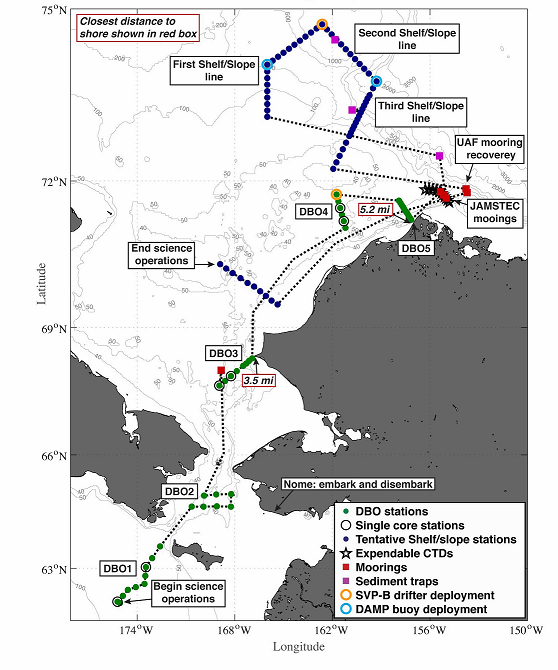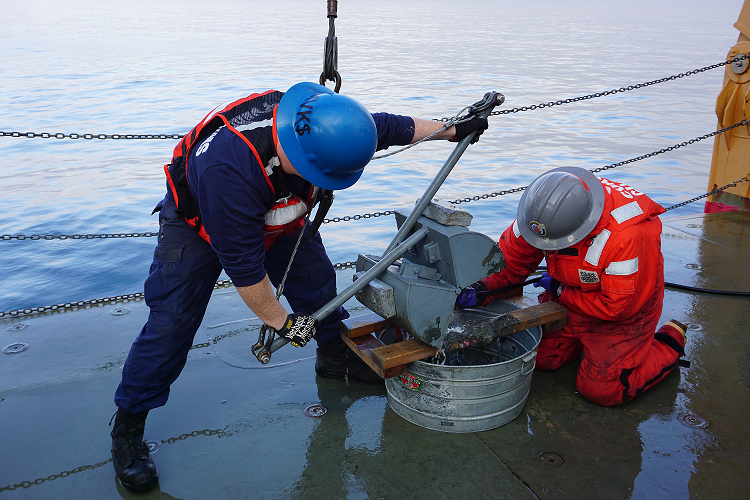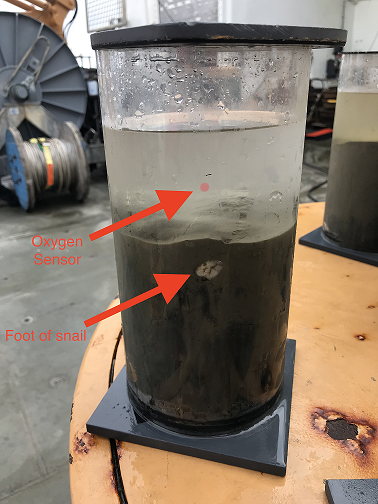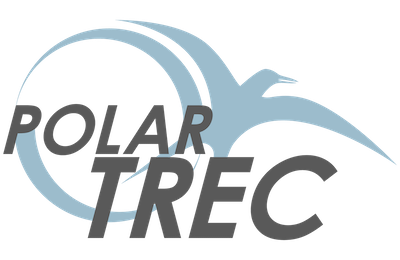The PolarTREC Field Experience
PolarTREC (Teachers and Researchers Exploring and Collaborating) is a professional development program that pairs K-12 teachers in the United States with polar researchers. Teachers engage in field research and develop long-term relationships with scientists in order to better understand the scientific process and implement the skills and knowledge they have gained into the classroom. The goal of PolarTREC is to inspire future generations of scientists by bringing authentic research into the classroom. PolarTREC is a very impactful professional development opportunity for teachers. Through my experience, I have:
- Learned about the Arctic ecosystem and how benthic organisms play a role in the health of the system
- Experienced first-hand the effects of climate change and what this means for the Bering and the Chukchi Seas
- Gained skills in data collection and the use of specialized equipment during while engaging in fieldwork
- Developed long-lasting relationships with my research team
- Created opportunities for outreach within my community and school
All of these experiences have culminated in better teaching practices and more resources for my classroom. My students have already begun to benefit from my involvement in PolarTREC through the implementation of my new skills and knowledge into my science curriculum. Future students will continue to benefit as the collaboration between myself and my researcher continues.
The Science Explained
The Northern Chukchi Integrated Study is an observational study looking at ecosystem response to climate change and other processes in the Bering and Chukchi Seas. This research is a part of the Distributed Biological Observatory (DBO), which is a series of sampling sites in the Pacific Arctic chosen for their high biodiversity and biomass. On my expedition, we were sampling benthic organisms at each of these DBO sites to continue what has been a long-term data set in the Arctic. All of the sampling was ship-based aboard the USCGC Healy.

We performed two types of benthic sampling to try to answer different questions. We deployed vanVeen grabs and HAPs cores to collect data from the ship.
vanVeen Grabs:
This instrument was invented by Johan van Veen, a Dutch engineer, in 1933 to collect sediments. When the Van Veen is deployed, it grabs 0.1 square meters of mud off the bottom and brings it back to the surface for us to look at.
This 117 pound (empty) instrument is deployed from the ship’s deck. It lands on the bottom, sinks into the mud, and closes when raised to grab the 0.1 square meter of sediment needed for a sample. Once the vanVeen returns to the deck, there are two types of data collected, surface mud and organisms.



HAPs Cores
HAPs core samples are a cylindrical puncture of the mud from the sea floor at DBO sites that are relatively undisturbed. During this expedition, these cores were used to calculate the oxygen consumption of organisms in a particular volume of mud. At DBO core sites, we collected 8 samples for experimentation.
The benthic team used a core cylinder mounted on a pyramid-shaped metal frame. The metal cylinder has a plastic Plexiglas liner in it that is used to store the core sample. When the corer is lowered into the ocean, heavy 100-lb lead weights on the top of the apparatus help to push the metal cylinder into the mud. Once the corer starts to come up, a metal arm swings down and under the cylinder to keep the mud sample from falling out. All of this has to be timed correctly in order to get enough benthic material on the bottom and some bottom water on the top of the cylinder in each core to measure the oxygen content.


Once on deck, the core is removed in the plastic cylinder and if necessary, trimmed to an optimal size for an incubation experiment. Small, fiberoptic oxygen sensors are positioned on the plastic cylinders. The mud sample, simulating the sea floor, sits a few inches below this sensor and the sensor measures the dissolved oxygen in the bottom water above the mud cylinder surface. The sensor therefore is positioned to read oxygen levels in the water overlying the mud core.



PolarTREC in the Classroom
There are several topics and concepts from my expedition that I will be tying directly to my classroom curriculum through lessons and activities. Although many of them are NGSS standard science concepts, I would like to tie in the Arctic and climate change for each of my ideas. They include:
- Climate Change in the Arctic: Climate change is a relatively new unit in my Biology and Marine Biology classes. I have acquired a number of resources that students can use to track the ocean temperatures and sea ice in the Arctic. I would like to have students download and manipulate this data to create future projections. Students will also be designing sensors that will be deployed on buoys at the mouth of the Piscataqua River here in New Hampshire so that they can collect their own data here to compare to the Arctic.
- Nutrient Cycling: In Biology, we talk about nutrient cycles that include oxygen, carbon, and nitrogen. The Bering and Chukchi Seas being very shallow, are highly productive and the cycles within this ecosystem include benthic organisms. I am planning on including specific nutrient cycling from the Chukchi Sea that includes data on how much is cycled. Students can then calculate how this will change if the biomass of benthic organisms decreases due to sea ice loss and increasing sea temperatures.
- Temperature vs. Oxygen Consumption: The HAPs core experiments during this expedition were looking at the effects of food and temperature on oxygen consumption. Studies have shown that oxygen consumption increases with temperature in certain organisms and ecosystems. I am designing an experiment for students to calculate the rate of oxygen consumption of periwinkle snails at different temperatures. They will calculate the rate and the upper temperature threshold for this species. They will determine their experimental temperatures by collecting tidepool water temperatures throughout one high and low tide cycle. Again, students will relate this to warming seas and draw conclusions.
- Biomass vs. Biodiversity: Using benthic videos taken from previous expeditions, students can learn to identify and measure the organisms on the sea floor. Students can analyze data through time to see how size and species have changed. There is intertidal transect data from coastal New Hampshire with similar data that students can look at as well and compare the two ecosystems and what factors cause the changes they see.
- Lab Sampling Equipment Design: In my classroom, students do a lot of modeling and design. I would like to have students design a small van Veen grabs with different sampling parameters and have them test them in a mud-bottom pond. Incorporating design and engineering shows students that there science is also about problem solving and finding the right equipment for the data you want to collect.
Public Outreach
Before the Expedition
Before I headed to Nome for my expedition, I several outreach opportunities. I spoke at the Dover Middle School in Dover, NH and Tributary Brewing in Kittery, ME. I also set up an activities table for a day at the Dover Children’s Museum in Dover, NH. This helped me to connect to the community and it also encouraged people to follow the expedition online.


After the Expedition
Since returning from my expedition, I have spoken at several places sharing what I learned aboard the Healy. I was also interviewed for a newspaper article and a television piece for New Hampshire Chronicle. Speaking about my expedition now that I have experienced the research is very impactful to my audience. I have this first-hand account that I can share with people and it makes them stop and think about what is happening with climate change and how it is affecting the environment and, ultimately, humans.
Post-Expedition Plans
I do have some future plans and expectations to continue my involvement in PolarTREC and foster my relationship with the research team.
- Continued Outreach: I plan to continue with my community outreach. I will be working with the Seacoast Science Center (SSC) in Rye, NH to incorporate what I have learned into their educational materials for K-12 students. I will also be working with the high school interns at the SSC to engage them in polar marine science as a part of their experience. I will be attending a local STEM night where I have specimens from the expedition for students to look at and explore.
- Conferences: I will be presenting at the Ocean Sciences Meeting in February 2020. My research team will also be attending. I will be speaking to the educational community about the importance of connecting students with researchers, my personal experience on PolarTREC, and how the research from my expedition can be implemented into the classroom.
- Collaboration with my Research Team: Dr. Cooper and I are planning to work on curriculum for the DBO with the ultimate goal of creating a website accessible to teachers. This project will help to inspire my future students and help other educators introduce the Arctic ecosystem into their classroom.
*This program is supported by the National Science Foundation under award 1918637. Any opinions, findings, and conclusions or recommendations expressed by this program are those of the PIs and coordinating team, and do not necessarily reflect the views of the National Science Foundation.
| Attachment | Size |
|---|---|
| Download Report8.61 MB | 8.61 MB |
This program is supported by the National Science Foundation. Any opinions, findings, and conclusions or recommendations expressed by this program are those of the PIs and coordinating team, and do not necessarily reflect the views of the National Science Foundation.
